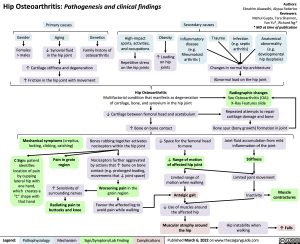Hip Osteoarthritis: Pathogenesis and clinical findings
Authors: Ebrahim Alawadhi, Alyssa Federico Reviewers: Mehul Gupta, Tara Shannon, Yan Yu*, Richard Ng* * MD at time of publication
Primary causes Aging
↓ Synovial fluid in the hip joint
Secondary causes
Gender
Females > males
Genetics
Family history of osteoarthritis
High-impact sports, activities, and occupations
Repetitive stress on the hip joints
Obesity
↑ Loading on hip joints
Inflammatory disease (e.g. Rheumatoid arthritis )
Trauma
Infection (e.g. septic arthritis)
Anatomical abnormality (e.g. developmental hip dysplasia)
↑ Cartilage stiffness and degeneration ↑ Friction in the hip joint with movement
Changes in normal hip architecture Abnormal load on the hip joint
Radiographic changes
See Osteoarthritis (OA): X-Ray Features slide
Repeated attempts to repair cartilage damage and bone
Bone spur (bony growth) formation in joint
Joint fluid accumulation from mild inflammation of the joint
Stiffness
Limited joint movement
Hip Osteoarthritis
Multifactorial condition that manifests as degeneration of cartilage, bone, and synovium in the hip joint
↓ Cartilage between femoral head and acetabulum ↑ Bone on bone contact
Mechanical symptoms (crepitus, locking, clicking, catching)
Bones rubbing together activates nociceptors within the hip joint
Nociceptors further aggravated by actions that ↑ bone on bone contact (e.g. prolonged loading, movements that ↓ joint space)
Worsening pain in the groin region
Favour the affected leg to avoid pain while walking
↓ Space for the femoral head to move
↓ Range of motion of affected hip joint
Limited range of motion when walking
Antalgic gait
↓ Use of muscles around the affected hip
Muscular atrophy around the hip
C Sign: patient identifies location of pain by cupping lateral hip with one hand, which creates a “C” shape with that hand
Pain in groin region
↑ Sensitivity of surrounding nerves
Radiating pain to buttocks and knee
Inactivity
Hip instability when walking
Muscle contractures
↑ Falls
Legend:
Pathophysiology
Mechanism
Sign/Symptom/Lab Finding
Complications
Published March 6, 2022 on www.thecalgaryguide.com
Foundations
Systems
Other Languages
Orthopedics Hip Hip Osteoarthritis: Pathogenesis and clinical findings hip-osteoarthritis-pathogenesis-and-clinical-findings

